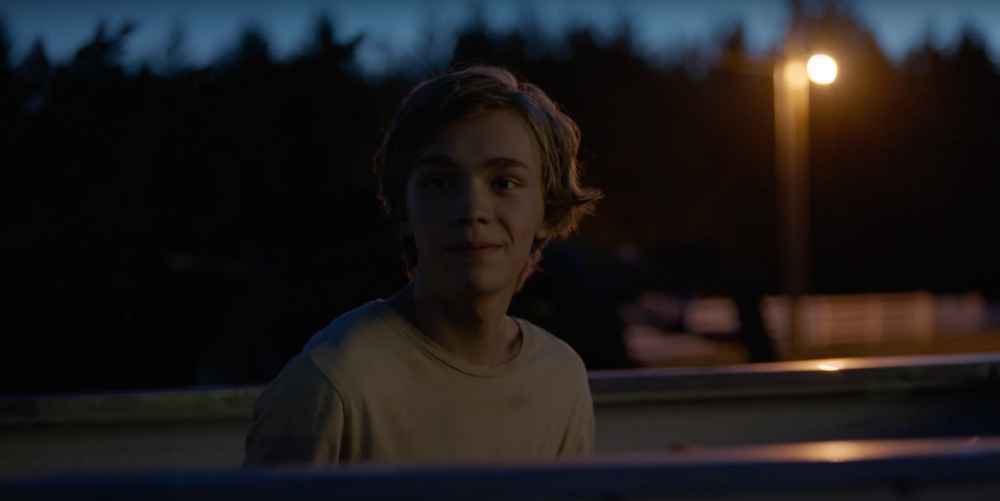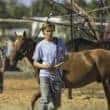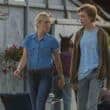DP Magnus Jønck approached Lean on Pete as a modern western, keeping the focus solely on character and de-romanticising the landscape. This is the second feature in our Special Issue on Lean on Pete, which is now available as an ebook here.

Lean on Pete may be set against the backdrop of the American west, but Magnus Jønck’s cinematography is surprisingly disinterested in lingering on those sweeping vistas. He visualises the story of 15-year-old Charley’s (Charlie Plummer) search for home with a constant focus on Charley himself. It’s all about how Charley relates to the landscape, which is at times both beautiful and daunting. He becomes a tiny figure swallowed up by an enormous desert, alone except for a stolen racehorse called Lean on Pete.
I talked to Jønck about how he approached de-romanticising the landscape and his process for working with writer-director Andrew Haigh’s meticulous blocking.
Seventh Row (7R): What did you work on with Andrew when you first joined the project?
Magnus Jønck: Before I was hired, I met with Andrew over Skype, and we talked for one and a half hours. Then it was a three week prep [period] — not a lot for a movie like that. The script was very clear, so I didn’t feel the need to discuss every scene.
When I got to Oregon, we went straight to location on a recce, because there were so many locations to see. When writing the script, Andrew did massive research and had been to all these locations. He had a lot of stills that he showed me to get me into the background of the story and horse racing.
[Andrew] had blocked pretty much all the scenes, been on location, and been writing for the locations. That made it very easy to talk about each scene because he was so prepared. On location, we would maybe adjust the blocking a bit, but we pretty much kept a lot of Andrew’s blocking.
What we talked about more on location was light and how we could use the background. For instance, in Charley’s house, we didn’t want to burn out the windows. We wanted to see how the outside world worked. The background was a big part of the naturalism and the authenticity of the film.
7R: How did the stills Andrew gave you help with your prep?
Magnus Jønck: Andrew is a very good stills photographer. Seeing what he sees, and where he puts himself when he takes a picture, helps me to get to know how Andrew would naturally frame things.
At Portland Meadows, he was there in the stalls during a race. Just seeing the stadium with all these people, you see where the light falls on their faces. You see all the colours, and that gives you a good starting point. You start deciding, “This is this colour”, building on what’s there already.
Authenticity is so important in this film, so it’s a really good reference to see how things are in real life. Maybe you don’t want to change it. Maybe you just want to keep it as it is.
[wcm_nonmember]
To read the rest of the article, purchase our Lean on Pete ebook
Enrich your viewing experience by snagging our ebook on the film.
[/wcm_nonmember]
[wcm_restrict]
7R: Did you shoot digitally?
Magnus Jønck: Yes, on Alexa.
7R: Was shooting on film an option?
Magnus Jønck: I think we could have pushed it. We discussed shooting on 35mm. Part of it was practical: we had three weeks in the middle of Oregon, so getting to see dailies would be practically challenging. I really like to see what we have sooner than two weeks after we shot it, so that was part of it.
But also, we had so many night scenes and magic hour scenes. That would have been very challenging [on film]. We had limited resources in terms of light. I do feel like the Alexa digital is better than film at night. It was a discussion. I still prefer film for shooting the daylight scenes. But we ended up with digital.
We didn’t want to romanticise the image or to be in any way nostalgic. We didn’t want that sentimental look. It felt like digital was a bit more true.
7R: How did you choose the 1.85:1 aspect ratio?
Magnus Jønck: Maybe because [Andrew and I] come from Europe, and we like the European arthouse scene. Maybe that was part of it. But also, we felt it was more true and more authentic, taking the edge off the whole filmic look.
7R: In a lot of westerns, the landscape is shot in widescreen, but you don’t do that. It’s definitely taking away the sentimentality of it.
Magnus Jønck: It’s not about the landscape; it’s still about Charley. It’s a very character-driven story. So it felt better to do it that way, to take away the obvious, beautiful images of landscapes.
Some westerns have these epic shots of the small cowboy in a big landscape. We talked about still having Charley as the main focus in the landscape. It’s not about showing nature. It’s about just being with him. We talked about what you’re feeling when you’re going through the landscape. Charley is alone, but he’s still in this big, beautiful, endless landscape. He’s really, really lonely, but there’s a kind of hope in the landscape.

7R: What else did you do to visually communicate the way Charley feels in the landscape?
Magnus Jønck: There is a point when Charley’s walking around, midday, in the sun. He’s been walking for a couple of days; he’s running out of water. How do you tell that story, that it’s super hot? It doesn’t show unless you’re on a really long lens. Even though we’re looking at Charley, we still want to feel how he’s feeling about the landscape.
It’s not enough just to add in a little warmth, like you see in movies. You add yellows and reds to the image, and it just naturally looks a little warm. We didn’t want to do that. We wanted to stay true. Actually, in the desert, even in Oregon, it’s quite blue. The colours are toned down. They’re not warm. So how do we tell that story?
7R: How did you choose the lenses you shot on?
Magnus Jønck: We wanted the vintage lenses for the softness they have, but we still wanted a modern look. We were fortunate enough to have the backside of Portland Meadows for the whole prep, so we did some lens tests in the real locations where we were going to shoot, to test colours and makeup.
We had a whole day of lens testing — in midday, late afternoon, magic hour — just to see how it worked. We tested all the lenses and we tested all the zooms, and eventually, we ended up with the lightest lens.
7R: How did you visualise the move from an objective gaze at the beginning to a more subjective gaze later on?
Magnus Jønck: We had a very good and thorough chat, in our very first meeting, about the story, Charley, about objectivity… Andrew has a very good way of putting it: it’s like when you meet a person for the first time and slowly get to know him: you get closer, and the person opens up more and more. That is also how he approached filming Charley: becoming more and more subjective.
It’s about observing, very clearly, in the beginning, and keeping a distance. You’re not up close with him. The camera can be in another room. It makes it very clear that you [are] observ[ing] another person when you’re not in the same room.
And then, as we go along, we slowly get to be less objective. There’s very few handheld scenes where you allow the camera to become emotionally involved in the scene rather than just looking at it.
7R: There are a very small handful of moments where the camera is allowed to be handheld and in close-up. How did you think about when those moments would be?
Magnus Jønck: It’s more emotional, [so it’s] when Charley’s more vulnerable. There’s kind of an action scene, when the father gets attacked, that was handheld. We have a handheld scene where, in the script, he’s breaking down — but in the edit, Andrew wanted to take that away and have the breakdown as the film is wrapping up.
It’s just about waiting. We wait and wait and wait until we can allow ourselves to care for Charley — to feel with him.
[clickToTweet tweet=”‘We wait and wait and wait until we can allow ourselves to care for Charley — to feel with him.'” quote=”‘We wait and wait and wait until we can allow ourselves to care for Charley — to feel with him.'”]
7R: Charley’s journey is very long, so you’re dealing with a lot of different locations — but you’re also envisioning an overall aesthetic for the film. How did you think about the visual elements that were going to connect everything?
Magnus Jønck: A big part of that is choosing a colour scheme. It’s a lot to do with production design: the aesthetics are pretty much the location. So [I worked on that] with Ryan [Warren Smith], the production designer, and Andrew.
We would take away colours, paint or repaint, [work to] keep the same earthy colours: starting a bit more neutral and going towards more saturated colours. We had an idea about having more vivid colours as [Charley] comes closer to the point where he’s homeless.
The first week of shooting, you get to know what film you’re doing and what works with the choices you have already taken. Every DP and every director have a way of framing and a way of seeing things, so you get an overall aesthetic naturally.
7R: So shooting chronologically helped?
Magnus Jønck: It’s so much easier when you know where you’re coming from. Like the audience, you slowly get to know the film better and better, and you get more and more into the rhythm.
I’ve actually shot a lot of films in chronological order. For the actors, it’s very helpful, so they know where they’re coming from. And obviously, there’s factors of light and weather. We had a lot of scenes where early morning and late afternoon is going into evening and night. We talked about how much light in the sky there should be. Should it be completely dark, or should there be some light left? You’ve got the answers right there when you’ve shot the scene the day before.
7R: How did you light those night scenes?
Magnus Jønck: At the locations, in prep, you want to see the colours — especially in Portland where there’s so many different colours of street lights. You want to see how they work, if you turn some of them off. It’s basically trying to work with the location and trying to stay true to the location. When Charley’s leaving the truck with the horse, we gave him a lantern. We just used the car lights and this lantern and enhanced it a little bit. I try to see how it looks naturally, to see if I should only use practicals — maybe try and clean it up a little bit, if it’s too messy and there’s light coming from too many directions.

7R: Was there a lot of work to simplify things in the frame?
Magnus Jønck: When you’re working on real locations, that’s kind of the thing, to simplify. Authenticity is very important, but at the same time, the focus still has to be on the actor and not a blue or red thing that’s in the frame. So you take away stuff that takes too much focus.
In the production design, it’s important that you don’t fill up the frame with a lot of stuff that doesn’t tell the story. The set design is also telling the story. Charley’s with his dad, moving from place to place, and they don’t have a lot of things, so each thing is a significant part of the frame. It stands out because there’s nothing on the walls, and you have to think if it fits in or not.
[clickToTweet tweet=”‘It’s important that you don’t fill up the frame with a lot of stuff that doesn’t tell the story.'” quote=”‘It’s important that you don’t fill up the frame with a lot of stuff that doesn’t tell the story.'”]
7R: How closely did you work with the production designer?
Magnus Jønck: There’s an aspect of getting to know each other. You’re tiptoeing a little bit in the prep. . Some directors really care [about production design], and it’s a big part of their prep; some directors don’t really care so much about it. Andrew cares a lot about it.
I came on only three weeks before the shoot. So getting to know the film came a bit slower than usual. We had a great relationship and great collaboration with the production designer, but it was more on the go.
Ryan was on the film before I got on board, so [he and Andrew] had thought about it already. As we’re getting into the actual shoot, you start talking about the colours and aging things. But we didn’t have a sit-down meeting where you talk about philosophy, the meaning of colours, or anything. We did talk a lot about Charley’s red shirt, because that is a very strong colour in a film.
7R: Because Andrew had a lot of the blocking worked out already, how did that affect your process?
Magnus Jønck: It was really helpful on this film, because the prep time was so short. Andrew is, at the same time as being super prepared, very open to my input. Whatever points I would have, he would really be listening to them. He brings you in.
We had a rule that Charley should be in every frame of the film. There’s a few scenes where we didn’t feel we needed to see who he’s talking to, because it’s people we’re never going to see again. Do we need to put a face on them? Is it actually going to be better if we don’t see them?
There were a few scenes that were a bit more challenging. For instance, for one of the races, you could only do one take with the racehorse, because we only had one set of horses, and they could only do one race. We wanted to do it in one take. So a lot of the blocking was very simple and without a lot of coverage.
[clickToTweet tweet=”‘We had a rule that Charley should be in every frame of the film.'” quote=”‘We had a rule that Charley should be in every frame of the film.'”]
7R: This is the first time Andrew’s worked with a dolly. Why was that right for this story?
Magnus Jønck: It was part of Andrew’s blocking. He already incorporated a dolly, naturally, because there’s a lot of walking in this film. It felt like it should not only be for the journey, though — it should be incorporated in the whole film. All the moves are pretty much just following Charley and following all the characters. We tried to keep it simple, keep it just for moving characters from A to B.
[clickToTweet tweet=”‘Andrew’s blocking is very complex, but it still has meaning. It’s not simple, but it’s simple what he’s trying to achieve.'” quote=”‘Andrew’s blocking is very complex, but it still has meaning. It’s not simple, but it’s simple what he’s trying to achieve.'”]
7R: Did the blocking change much during shooting?
Magnus Jønck: It was more fine tuning: walking around, being there with a viewfinder, fine-tuning how the extras in relation to our character should walk… that kind of stuff.
Andrew’s blocking is very complex, but it still has meaning. It’s not simple, but it’s simple what he’s trying to achieve. There’s no, “Why should we do that?” It’s basically just Charley, or someone, walking from A to B.
Read the rest of our Special Issue on Lean on Pete here >>
When we talked to DP Jakob Ihre about Thelma, he talked about his reluctance to shoot digitally and the methods he used to replicate the look of film. Some directors are resistant to shooting on digital for the first time, like Lynne Ramsay with You Were Never Really Here, whereas Sweet Country DP-director Warwick Thornton takes a more matter-of-fact view of digital shooting: “It’s the way it is. Get over it.” Director Yann Demange discussed using both the digital Alexa camera and 16mm film to shoot different parts of ‘71.
[/wcm_restrict]

